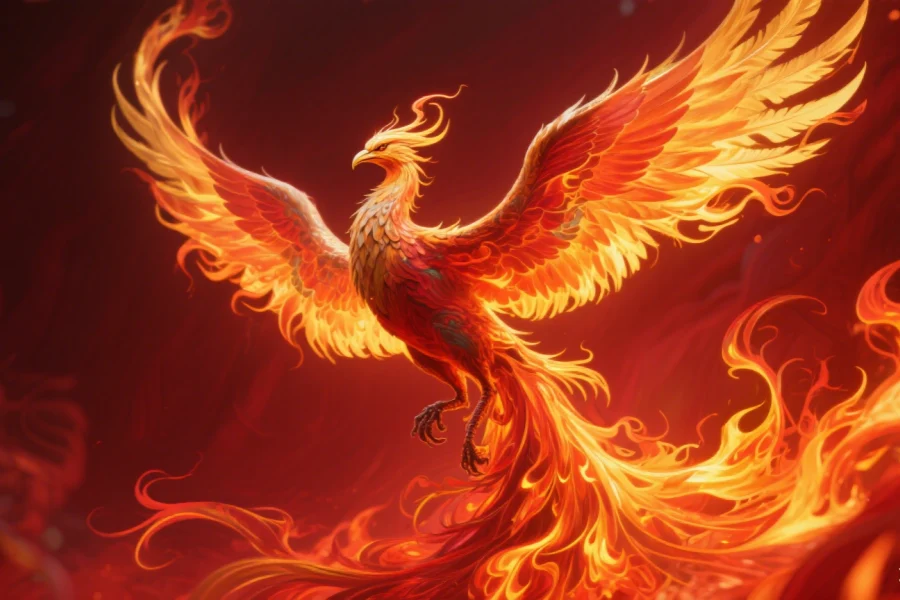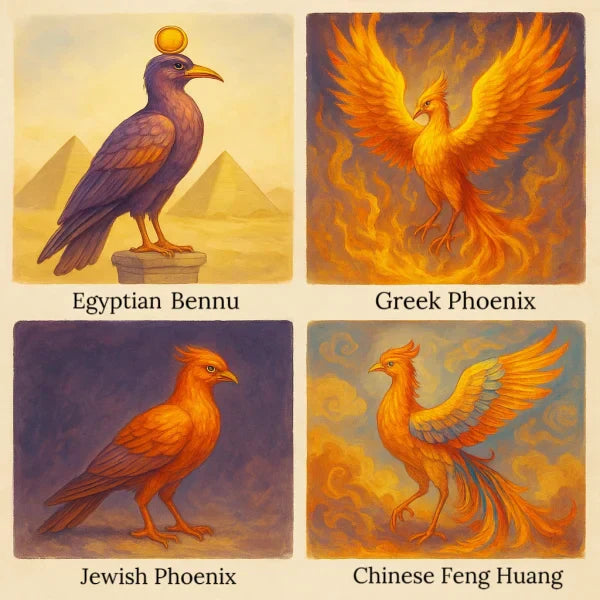Introduction
The Phoenix is more than just a bird; in fact, it's a story that will never die. Known across cultures as the creature that bursts into flames and rises again from its own ashes, the phoenix bird stands for resilience, transformation, and new beginnings. You won't find it nesting in trees or flying through real skies. Instead, it lives in ancient myths, modern tattoos, fantasy novels, and even personal mantras, wherever people need a reminder that endings can spark new starts.
In this guide, we'll explore what makes the Phoenix so unforgettable, its meaning, its origin stories, and how writers and artists have portrayed it over time.

What is a Phoenix Bird?
The Phoenix bird is no ordinary creature. Shaped by centuries of storytelling, this mythical creature is a symbol of life beyond death. According to myths, it lives for hundreds, or even thousands, of years.
When its time comes, the Phoenix builds a nest of cinnamon twigs and aromatic herbs, then sets it ablaze. From those very ashes, it rises again, reborn, untouched by death.
Though many link the Phoenix to Greek and Roman myths, the story isn't limited to one place. Cultures around the world share their own versions. The Egyptian Bennu and the Chinese Fenghuang each echo the same theme: renewal through fire.
Even its name tells a story. "Phoenix" comes from the Greek word for red and purple, inspired by the bird's dazzling, flame-colored feathers.

What Does the Phoenix Look Like?
The appearance of the Phoenix varies from one culture to another. In some traditions, people describe the Phoenix as the size of an eagle; others debate that it's even larger than an ostrich.
Nevertheless, what most versions agree on is its vibrant, flame-colored plumage. Its feathers are commonly described in shades of red, orange, purple, and gold. In some myths, it takes on a peacock-like look, complete with long, flowing tail feathers.
In addition, the Jewish dramatist Ezekiel the Tragedian described the Phoenix bird as having red legs and striking yellow eyes. Despite the differences in detail, every myth depicts the Phoenix as powerful and immortal.

Origin of the Phoenix Bird in Different Methodologies
The Phoenix appears in many cultural myths across the world. Here are a few of the most famous tales.
Greek Mythology
The Greek version of the Phoenix is the most well-known. Greek historian Herodotus mentions in his writings:
"There is another sacred bird, too, whose name is Phoenix. I myself have never seen it, only pictures of it, for the bird seldom comes into Egypt: once in five hundred years, as the people of Heliopolis say." Herodotus, Histories Book II. 73.1
In Greek mythology, the Phoenix originates from Arabia and lived for 500 years. As its life comes to an end, it builds a nest filled with fragrant herbs, sets it on fire, and consumes itself in the flames. From those ashes, a new phoenix would rise, reborn, and carry the remains of the old bird to the temple of the sun.
Another legend states that Apollo, the God of light and sun, once stopped his chariot to listen to the mythical bird's song. Many people believe that the bird may have been a phoenix.

Ancient Egyptian Mythology
In ancient Egypt, the myth of the Bennu bird, often linked to the heron, laid the foundation for the phoenix legend. According to the myths, Bennu rose each day with Ra, the Sun God. As a result, this daily rebirth, tied to the rising sun, deeply influenced later phoenix myths.
According to these early stories, when the Phoenix approached the end of its life, it built a nest from fragrant branches of cinnamon and spices. With a flap of its wings, it set the nest ablaze.
The new Phoenix rose from the ashes of its predecessor and carried the ashes to the city of Heliopolis. Additionally, it placed those ashes on the sacred altar of Ra, thereby highlighting the connection between the Sun God and the Phoenix.

Chinese Mythology
In Chinese folklore, the Phoenix, known as the Feng Huang, represents the celestial counterpart to the emperor's dragon. While the dragon symbolized masculine power, the Feng Huang represented feminine grace and virtue. Its image often adorned the empress's robes, symbolizing harmony, royalty, and balance.
Unlike the Western Phoenix, the Feng Huang was a blend of many birds. It was said to have the head of a pheasant, the body of a duck, the tail of a peacock, the legs of a crane, the mouth of a parrot, and the wings of a swallow.
Each part of its body represented different celestial elements. Furthermore, the legends believed it originated from the sun, an eternal symbol of cosmic order and rebirth.

Jewish Mythology
In Jewish tradition, the phoenix appears in the Talmud under the name “Chol.” According to legend, this bird lived in the Garden of Eden. When Eve offered the forbidden fruit to the animals, only the Chol refused. As a reward for its obedience, God granted it immortality.
Additionally, another Talmudic story places the phoenix on Noah’s Ark. In this version, the bird earned praise for its selflessness; it never asked for food, sparing Noah the extra burden during the flood. Thus, both tales portray the Phoenix as a symbol of virtue, restraint, and divine favor.

Myths and Interesting Facts About the Phoenix Bird
The Phoenix may have originated in Greek or Roman mythology, but over time, its legend spread across the world. Every culture adds its own meaning to this majestic bird, enriching the myth with new details.
From ancient coins to modern city names, the Phoenix has become a global symbol of transformation, endurance, and rebirth. Here are some of the most intriguing myths and facts linked to this legendary creature:
Fact 1: A City Named After a Legend
The city of Phoenix, Arizona, takes its name directly from the legendary bird. Built on the ruins of the ancient Hohokam civilization, early settlers saw it as a symbol of rebirth. Moreover, they believed that, like the Phoenix rising from its ashes, a new city could rise from the remains of the old. Today, Phoenix stands as a modern symbol of renewal, just like the myth that inspired its name.

Fact 2: Atlanta's Symbol of Rebirth
The city of Atlanta in the United States adopted a city seal in 1887, with a phoenix at its front. The mystical Phoenix was a symbol of Atlanta's rebirth following the destructive Civil War in 1864.

Fact 3: Phoenix in the Fictional World
The legend of the Phoenix continues to inspire modern fiction. For instance, in Harry Potter and the Order of the Phoenix, the secret society led by Dumbledore takes its name from the mythical bird. He even owns a phoenix named Fawkes, known for its healing tears, loyalty, and fiery rebirth.
Furthermore, the Phoenix also makes an appearance in the Marvel Universe. The Phoenix Force, introduced in the X-Men series, is a powerful cosmic entity that embodies life, death, and rebirth, mirroring the very essence of the myth.

Fact 4: Represents Christ's Resurrection
In Christian beliefs, the Phoenix's life reflects events in the life of Christ since it closely represents resurrection. According to the myth, the Phoenix dies in flames and rises again from its ashes.
This cycle of death and rebirth parallels the death and resurrection of Jesus Christ, making it an integral symbol of eternity in Christianity.

Discover More Birds Like the Majestic Phoenix Bird
The Phoenix bird may not exist in flesh and feathers; however, its presence in myth, art, and culture is undeniable. It gives form to an eternal idea that no matter how dark the moment, there's always a chance to begin again, stronger and wiser than before.
While the Phoenix is a mythical bird, nature is filled with other awe-inspiring species that spark the same fascination. Want to get a closer look at them?

FAQs about the Phoenix Bird
Is the Phoenix bird considered good or evil?
The Phoenix is widely seen as a symbol of good. In many traditions, it represents hope, rebirth, and transformation. Furthermore, some even link it to the resurrection of Christ, reinforcing its image as a sign of eternal life and renewal.
Is the Phoenix a real bird?
The Phoenix is not a real bird; it only lives in myths and legends. While entirely mythical, real birds with striking features that captured human imagination may have inspired the Phoenix. For example, the Onagadori and phoenix chicken breeds, with their bright plumage and long tails, may have contributed to the legend.
Is the Phoenix a satanic symbol?
The Phoenix bird is not associated with satanic symbolism. On the contrary, early Christian writings used it to represent the resurrection of Christ. Chinese phoenixes also attribute it to values such as honesty, faithfulness, and worship.
Additionally, Egyptian mythology associates it with the God of the Sun, contradicting any connection with Satanism.
What is the power of a phoenix?
The Phoenix is a rare and powerful magical bird that can burst into flames and be reborn from its ashes, allowing it to live for an exceptionally long time.
Is there a phoenix in Harry Potter?
In the Harry Potter series, Professor Dumbledore has a loyal pet phoenix named "Fawkes." It helped Dumbledore fight Lord Voldemort and protected him against a killing curse in the fifth book of the series. Additionally, he also heals with tears and is capable of carrying heavy loads.




Leave a comment
All comments are moderated before being published.
This site is protected by hCaptcha and the hCaptcha Privacy Policy and Terms of Service apply.